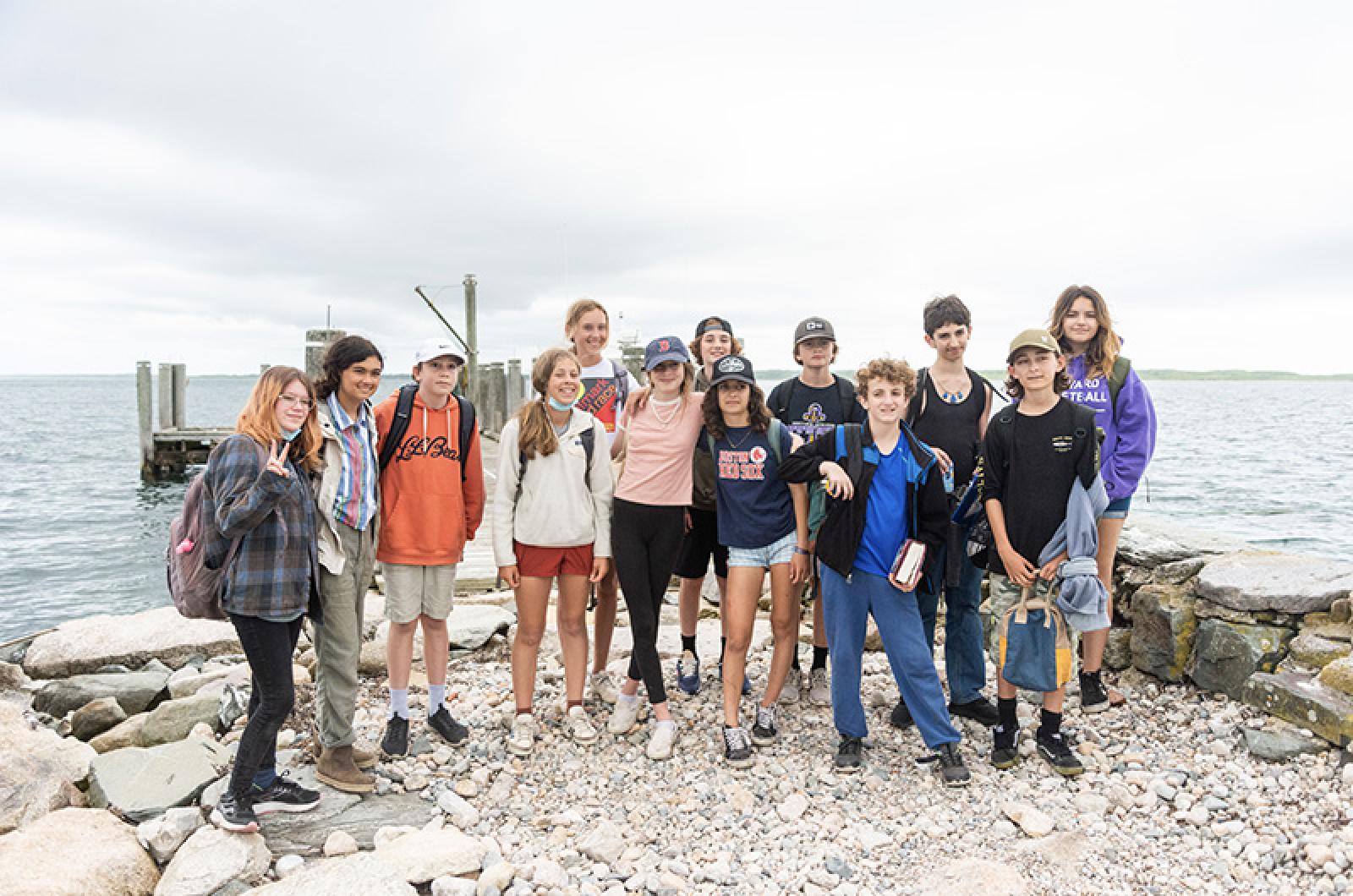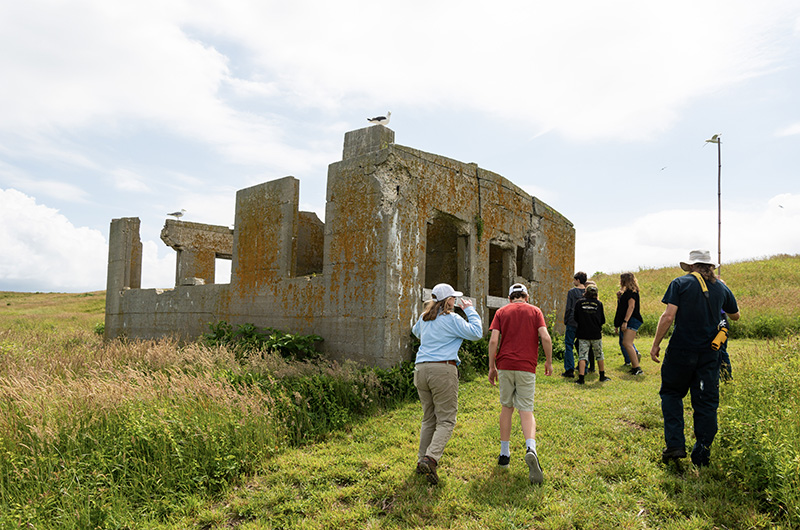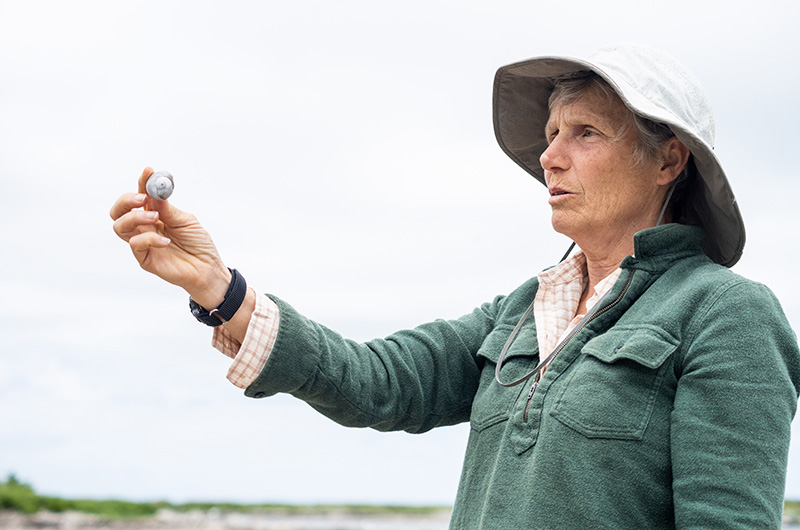As the academic year wound down last week, West Tisbury school seventh graders boarded a boat and sailed from Menemsha for a day of outdoor learning and exploration. What they found, just 10 miles from the harbor, was an intersection between science, nature and history on Penikese Island.
Situated just north of Cuttyhunk and Nashawena, Penikese is a state-owned island in Gosnold spanning 75 acres. The island is inhabited by gulls, oystercatchers, terns, snakes and rabbits. Very few trees grace its hilly plains, and rocks lace its jagged shores.
“You have to be pretty well adapted to this environment,” said trip guide Crickett Warner.
Ms. Warner is the director of operations for Penikese Island School, the Woods Hole-based nonprofit that hosted the field trip. She and fellow guide Patti Keating gave West Tisbury school seventh graders a full tour of the island, underscored by environmental science and history.
“This was a summer fishing ground for the Wampanoag for thousands of years,” Ms. Warner said.
Throughout the day, the stories of Penikese revealed themselves to students, beginning with the island’s main house. From 1973 to 2011, the island was a school populated by groups of boys in rehabilitation for serious offenses, acting as an alternative to juvenile detention. The main building that welcomes visitors to the island, now occupied largely by scientists and island caretakers, was their home.
Inside the main house Shawn Campbell’s name is scribbled among dozens of others boys, marking his height from his time at the school for boys. He turned 18 on the island then, and last Friday he celebrated his 40th birthday on Penikese — this time as part-time caretaker. He greeted the group as the boat pulled in and led students to the house from the dock.
“The house was really cool,” said seventh grader River Maxner.
Ms. Warner said she is proud of the Penikese Island School’s ability to allow more people to experience the island. When it was a correctional school, the island housed only around a dozen students at a time. Now camps and field trips bring many more students to the Island.
“I’m really excited,” Ms. Warner said. “We got 200 kids out here [this year].”
The seventh graders’ plunge into history continued with a walking tour of the island, where students found crumbling structures remaining from the island’s time as a colony for patients of leprosy in the early 1900s. Ms. Keating walked the group through the remains of a gate that once marked the divide between the leper colony and what was once called the “clean” part of the island, where people would drop supplies for the island residents.
“They never went on the other side of the gate,” she said.
The tour wound around the island’s trails, passing nests of hundreds of gulls, many of which swooped down at the group as tour guides held up long sticks to keep the gulls at bay. Near a dilapidated laundry house, students entered a small graveyard where residents of the leper colony were buried after they succumbed to the disease.
One of the people buried at the site, Ms. Keating said, is Archie Thomas. Mr. Thomas was a teenager then who operated a ham radio from the island to communicate with passing ships during World War I. He used what he learned from his conversations to build a newsletter for the leper colony’s residents, constructing one of the island’s only avenues for information from the outside world.
“For me, more than anything, it’s a sense of place,” Ms. Warner said, ruminating on what makes the island special.
She said that sense of history acts as a jumping off point for experiential learning and creates an environment that encourages exploration when visiting the island. West Tisbury school students got their chance to explore during a lesson taught by Ms. Warner on the island’s marine environment. Students spent an hour beachcombing, gathering rocks, shells, metal, ceramics and seaweed for later analysis.
For the most daring of the students, the time allowed for a fierce crab hunt. Frequent shouts of “It’s a boy!” and “This one’s a girl!” cut through the calls of gulls and the sound of gentle waves breaking on the shore.
“These kids have spent so much time on their screens,” Ms. Warner said. “We want to teach, but we also want time to get hands-on.”
She quizzed the kids on their spoils from the hunt, asking for the names of different seashells, rocks and seaweed.
“You guys are good, you know your shellfish,” she said.
Ms. Warner held up a piece of plastic found on the beach, which sat among other litter like pottery and corroded metal. She stressed the effects that discarded plastic has on marine life.
“The truth is, it never goes away,” she said. “It will be here forever.”
Though the school year has ended, learning on Penikese will continue throughout the summer. Starting in July, the Penikese Island School will
host sleep-away science camps for girls, aiming to broaden the pool of women in scientific fields. During the week-long excursions, campers spend their time learning from a group of all-female counselors and guest speakers in scientific fields.
“They eat, sleep, live here,” Ms. Warner said. “I’m really excited to get the girls feeling confident.”
The Penikese Island School bears the name once held by the school for delinquent boys. The program also carries with it a legacy of learning on the island that began in 1873, when Swiss-American naturalist Louis Agassiz founded a school of natural science on Penikese. The original school didn’t last very long, but spurred academic growth in nearby Woods Hole. Some of Mr. Agassiz’s students went on to found the Woods Hole Marine Biological Laboratory in 1888.
With hundreds of students and campers arriving every year, a new chapter of education and inspiration on the island has only just begun.
“There’s no barriers to entry,” Ms. Warner said. “We’ll do whatever we can to get you here.”










Comments
Comment policy »